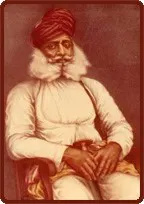Exploring the Essence of Shree Natnagar Shodh Samsthan
Experience the legacy of Maharajkumar Dr. Raghubir Sinh through an unparalleled collection of manuscripts and artifacts at Natnagar Shodh Sansthan.

Maharaj kumar Ratan Singh
Maharajkumar Ratan Singh was born in the palace of Laduna to the queen of Raja Raj Sinh – Rajkunwar Chawdiji – on Monday, April 11, 1808 (Vaishak Vadi 1, Vikram Sanvat 1865). His childhood was spent entirely in the palaces of Laduna. Not much is known about the childhood of Ratan Sinh, but it is well-known that a lot of his time was spent in physical exercise and hunting apart from education. Through regular workouts, Ratan Sinh’s physique had become powerful and well-balanced. There are a lot of tales in circulation about his physical strength. Under the suitable guidance of Raja Raj Singh, Ratan Sinh studied languages including Urdu, Persian, Hindi, Brij, Sanskrit, and Dingal. By inspiration of his father and teacher Guru Shrupdas, Ratan Sinh started writing poetries in Hindi, Brij, Dingal, Persian, and Urdu, under the pen name of ‘Natnagar’.
In Vikram Sanvat 1913, ‘Natnagar Vinod’ was created. In this epic poem of his, Ratan Sinh has described both aspects of `Shringar’ – `Sanyog’ and `Viyog’ beautifully. The composition is also grammatically beautiful and language-wise lucid. `Natnagar Vinod’ is mostly a tribute to the Brij language, but yet in some places shades of regional dialects of Malwa could be seen. Along with this epic poem, Ratan Sinh had also penned `Deewan-e-Usshaq’ in Urdu, an unpublished copy of which is still available in the Natnagar Shodh Samsthan.
Along with a love for literature, Ratan Sinh was also fond of painting and music. He was also fond of horse riding. He had written `Ashwa Vichar’ on special attributes and qualities of horses.
Maharajkumar Ratan Singh was considerably impressed by Dadupanthi saint Shrupdas and considered the latter as his teacher. Shrupdas was a great Sanskrit scholar. The correspondence between Ratan Sinh and Shrupdas could be seen in Natnagar Vinod. The correspondence was in poetic form. The collection of this correspondence is also available at Shree Natnagar Shodh Samsthan, Sitamau. Ratan Sinh was quite famous in the world of poets because of his love for poetry and writing. Poets like Suryamall, Chandidaan, Hariram, Gurubhai Shivram, and Shyamrao were part of his literary group. Apart from writing poetry, Ratan Sinh was also an avid collector of volumes of poetries. He got several poetry volumes copied and collected them. The administration of Sitamau was also his responsibility. To resolve the `tanka’ (tax) related issues of Sitamau State, Ratan Sinh toured Gwalior in 1860. He met Maharaja of Gwalior Jayajirao through British official A.G.G. Shakespeare and managed to get a discount of Rs 5000 in the `tanka’ by impressing the Maharaja with his speaking style. While returning from Gwalior, Ratan Sinh took a holy bath in the Ganges and also visited Brijbhumi.
Maharajkumar Ratan Singh died in unfortunate circumstances after falling from a horse at the age of 55 years at midnight on Tuesday, Magh Vadi 3 Vikram Samvat 1920 (January 26, 1864).
Establishment of Shri Natnagar Shodh-Samsthan, Sitamau
Maharaj Kumar Ratan Singh was the son of Maharaja Raj Sinhji (1802-1867) the ruler of Sitamau State. He was a poet and shayar and his pen name was “Natnagar”. He had a good knowledge of Brij, Dingal, and Urdu languages. He had authored “Natnagar Vinod” in Brij and “Diwan-i-Ushhaq” in Urdu. Dr Raghubir Sinh established an institute in his pen name.
Read More
Shri Natnagar Shodh Samsthan, Sitamau was established by Dr. Raghubir Singh on Aug. 14, 1974, as an autonomous Research Institute to further the advancement of knowledge and learning by promoting historical research and studies and providing historians and researchers essential records, manuscripts, printed books, and other necessary primary and secondary source materials, etc. for the same.
It was registered under the Madhya Pradesh Society Registirkaran Adhikaran, 1973 (No. 44 of 1973), at No. 4081 on Jan. 16, 1975.
Since then it has been growing rapidly and is now a well-developed Research Institute with an experienced eminent historian as its Director and a regular staff of trained researchers carrying on specifically planned programs of historical research including editing of important historical work and other primary sources materials.
Shri Raghubir Library, Sitamau (formerly the personal library of Dr. Raghubir Sinh) is the noteworthy main component unit of the Samsthan. This library has been well known for more than the last sixty years as a self-contained institution for research in Indo-Muslim and Maratha history and has been highly spoken of by many eminent historians, including Acharya Jadunath Sarkar. Some well-known historians of the present day and many other research scholars supplicating for their Ph. D. and D.Litt. thesis from various Indian Universities from far and wide have been coming down to Sitamau for the last forty years and more.
Constant efforts are even now being made to further enrich the Shri Raghubir Library by collecting the latest publications relating to the particular fields of its specialization, and other work which was wanted previously. Moreover, xerox prints, micro-films, or copies of additional primary sources of the relevant period are being obtained, and important historical manuscript collections in private possession, like the Kaviraja Collections at Jodhpur, are also being duly acquired by the Samsthan for the said Library.
The Madhya Pradesh State Government has duly recognized Shri Natnagar Shodh Samsthan, Sitamau as a ‘Special Institution’ and is giving it a grant-in-aid with effect from the financial year 1975-76. The State government is duly represented on the Managing Board of the Samsthan.

